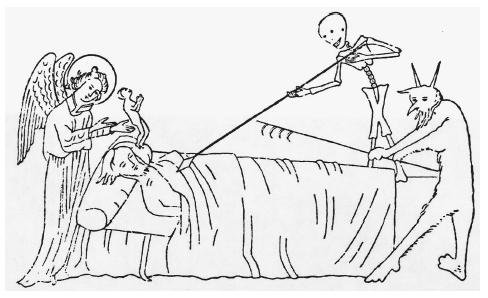Part One considered the “before” of end-of-life care (and once again, Bill Keller’s piece is recommended reading: check it here), and this excerpt (from Keller, then me) deals with the “during”, and the unanticipated, if revealing way many doctors handle things when they are the ones getting the grim diagnosis.
Terminal illness –and how best to process it– is not remotely an easy to discuss, describe or resolve dilemma. The primary issue, it seems to me, boils down to awareness (which, come to think of it, applies to virtually every situation): it might be easy to blame the doctors or the system, or even the families, but we are currently ill-equipped to have open, honest discussions about treatment options vs. realistic scenarios, and in America especially, our one-two punch of denial and deference to authority leads to many well-intended instances where pain and suffering is prolonged in the name of hope. Keller’s article indicates we can learn a lot from our brethren across the pond, where humane and mature solutions are not met with hysterical screams of ‘death panels’ and the like…
But the hospital that treated him offers a protocol called the Liverpool Care Pathway for the Dying Patient, which was conceived in the 90s at a Liverpool cancer facility as a more humane alternative to the frantic end-of-life assault of desperate measures. “The Hippocratic oath just drives clinicians toward constantly treating the patient, right until the moment they die,” said Sir Thomas Hughes-Hallett, who was until recently the chief executive of the center where the protocol was designed. English doctors, he said, tell a joke about this imperative: “Why in Ireland do they put screws in coffins? To keep the doctors out.”
The Liverpool Pathway brings many of the practices of hospice care into a hospital setting, where it can reach many more patients approaching death. “It’s not about hastening death,” Sir Thomas told me. “It’s about recognizing that someone is dying, and giving them choices. Do you want an oxygen mask over your face? Or would you like to kiss your wife?”
Anthony Gilbey’s doctors concluded that it was pointless to prolong a life that was very near the end, and that had been increasingly consumed by pain, immobility, incontinence, depression and creeping dementia. The patient and his family concurred.
And so the hospital unplugged his insulin and antibiotics, disconnected his intravenous nourishment and hydration, leaving only a drip to keep pain and nausea at bay. The earlier bustle of oxygen masks and thermometers and blood-pressure sleeves and pulse-taking ceased. Nurses wheeled him away from the wheezing, beeping machinery of intensive care to a quiet room to await his move to “the other side.”
***
Doctors talking about death are not unlike priests describing the horrors of hell: there is the air of presumptive jurisdiction, but also an aloof conviction, almost pitying, that affirms it’s not a place (death, hell) they’ll ever find themselves. We cannot despise them for this: without these affectations that eventually become ingrained, they could not conceivably perform their functions. Their comportment suggests that they have seen many of the things we pray to avoid, and have become intimate with horrors we can hardly imagine. In order to acclimate, they must first fortify themselves.
Physician, heal thyself?
It is understandable that so many of us assume doctors, who have more of everything—knowledge, money, connections—are able to take care of each other in ways their patients cannot conceive. If this were indeed the case it would be comforting in a way. At least we would have irrefutable evidence that solutions do exist and we might look forward to one day employing them ourselves.
But the reality, if less polemical, is nevertheless enlightening. According to a growing field of first-hand testimonials, doctors do in fact tend to die differently, but not as a result of special or preferential treatment. The ultimate, paradoxical disparity lies in an intentional demurral of treatment. Less last-ditch cycles of chemotherapy or illusions of a few extra months—itself a proposition that begs the complicated question: does more time with more adversity (physical if not mental) seem in any way appealing?
This phenomenon, which could simply and accurately be described as acceptance, illustrates several things. The most revealing might be the consequence that doctors see enough avoidable anguish they are disinclined to die in denial when their own diagnoses stare back at them in black and white. Aware of how little can be done, and able to measure the difference between best intentions and bottom lines, some prepare accordingly. In the process, perhaps they are able to provide a measure of peace—and not the opposite—for themselves and their families.
*excerpted from a memoir entitled Please Talk About Me When I’m Gone.

